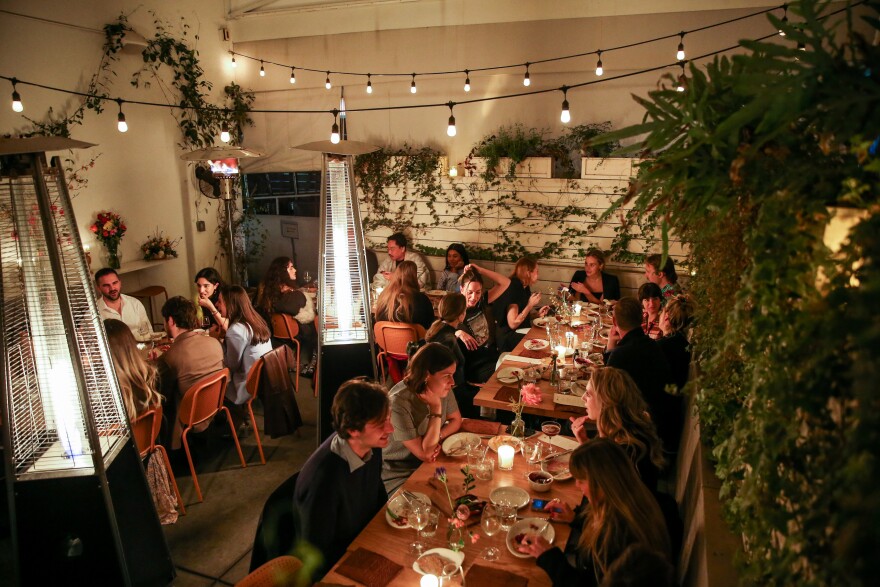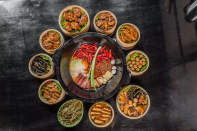Truth matters. Community matters. Your support makes both possible. LAist is one of the few places where news remains independent and free from political and corporate influence. Stand up for truth and for LAist. Make your year-end tax-deductible gift now.
From fast-food to fine-dining sticker shock, why restaurant math isn't working for anyone

You’re a working person in Los Angeles. A life milestone approaches which calls for a night out with dear ones. You make a reservation. You go. A moment of gratitude as you look around the table.
But then you’re handed the bill.
Suddenly, you’re feeling a little less grateful and are questioning your choices. But you realize, as you hand over your card, that even with $100-plus tabs for basic sit-down meals and $60 or more for weeknight takeout, the closures of scores of eateries — All Day Baby, Bicyclette, the venerable Rose Cafe, the Original Pantry — haven't stopped.
What's going on?
We spoke with three L.A. restaurant proprietors across a range of price points to try to understand how the math works — or doesn't.
We asked them to drill down on a specific entrée on their menu, and compare its price today to its price in pre-pandemic 2019. We also asked them to compare food costs, staff wages and money spent on overall operations.
A few caveats: First, hats off to these owners for their transparency, as many others were reticent to allow a peep into their books. Second, although we'd have liked to use the same line items across eateries, each place had different ways to get to the final numbers, which we respected. Some shared greater specificity with the costs while others were more free with their feelings.
Here’s what they said.
Botanica Restaurant (mid-priced, Silver Lake)
Turkish Eggs

Heather Sperling was a veteran food editor before she got into the restaurant business with Botanica.
While she had an idealistic vision for the type of restaurant she wanted to create with partner Emily Fiffer in 2017, she figured she had also learned the tried and true formulas for the business side through her experience interviewing pros in industry.
One of those formulas was to aim for a 25% food cost. That meant you'd take the cost of all the ingredients, and multiply by four to arrive at the final price. This formula accounted for labor, utility and services costs, and hopefully achieved around a 5% profit margin, considered healthy for a restaurant.
Because Sperling and Fiffer are obsessive about quality sourcing, however, they always knew that food costs would go over 25% by a percentage point or two. But post-Covid, food costs rose to about 30%.

To outsiders, those few points might not seem gargantuan, but according to an op-ed Sperling wrote for the L.A. Times, for every $1 a customer spent in 2023, $1.005 went out the door. In the last quarter of 2024, they were at a 2% profit margin — thanks to catering.
Meanwhile labor costs have increased 40% since Botanica opened in 2017, with the attendant higher workers comp insurance rates. And sundry other expenses have risen too, like hiring cleaners every quarter to service the hood and ventilation system, getting the grease trap emptied, the fryer oil picked up, linen rentals, propane tank rentals, and repairs for the walk-in refrigerator.
All this leaves the restaurant not only with the actual cost of what a dish should be, but also an “emotional” or “contextual cost” — that is, what it's possible to charge for a dish that will make sense to a customer.
“You can have a starving artist creating for art's sake, but that doesn't really translate to a restaurant at a certain point — the restaurant is just going to fail", she says.
Figuring out this near-impossible riddle hasn’t completely dampened Sperling’s enthusiasm for operating idealistic restaurants that care about where their ingredients come from. She recently partnered with Lucia Flors and Carlos Leiva to co-open Silver Lake’s Bar Siesta.
Still, times are admittedly fraught.
“That's why I get so sad and concerned as the costs of doing business continue to rise. I get so worried for the future of these incredibly special, meaningful businesses that are totally devoted to the artisanal magic of making great food.”
Bone Kettle (moderately expensive, Pasadena)
Bone kettle noodles in broth with oxtail

The restaurant that was able to give the most specificity was Bone Kettle, a Southeast Asian Kitchen and Bar in Pasadena.
Chef Erwin Tjahyadi says in the past two years, oxtail has risen to $16-$18 per pound, up from $9-$11, as it's become an increasingly popular restaurant commodity. (Bone Kettle uses prime-grade oxtail meat from Idaho and Nebraska farms.)
Meanwhile the cost of noodles has almost doubled to 78 cents for an 8 ounce portion, up from 42 cents

Although the dish is popular, Bone Kettle has about a 40% margin on the dish.
Appetizers and vegetable dishes have up to a 50% margin.

Before the pandemic, they’d shoot for a 70% margin on those dishes. But due to inflation and current economic conditions, they’ve had to cut it to 50%, taking into account the price-points of neighboring restaurants with similar cuisines.
The current uncertain political environment also is having an effect, he says. “Everything is still kind of up in the air. That's the reason why ... people are not really spending money right now.”
But time will tell, he says, if things stabilize, just like after the Great Recession. “Beef and pork go up and down like the stock market.”
FOOD (fast-casual, Cheviot Hills)
Grilled Chicken Sandwich, with salad, soup or bag of chips

For Judy Ornstein, at FOOD, a fast-casual day-spot on Pico Boulevard in Cheviot Hills, there’s no easy way to understand the recent plight of Los Angeles restaurants.
“Everything sucks,” she says, matter-of-factly, after a friendly wave to a regular on their way out. “Nothing makes sense.”

Of course, Ornstein, who opened two other restaurants in her life, is talking about the cost of doing business, which is fluctuating all the time.
“If I tell you that it costs me $5 to make a sandwich, OK? Like, who cares? Because today chicken costs $3 per pound. Tomorrow, chicken costs $7 per pound. You know, it's like a much bigger picture,” she says, pointing out the volatility of the numbers.
But there's also daily minutiae. Like, she says, even plastics have gone from 3 cents a container to 45 cents. Everyone is passing down their own higher cost burdens, except there’s only so much a restaurant can charge a customer without turning them off.
And there are new costs to contend with. During the pandemic, the city allowed outside seating. FOOD accommodated about 40 diners along their sidewalk. Now, the city requires you to have a permit that costs thousands of dollars, she says.

But some of it has nothing to do with these supplemental expenses. FOOD is close to Century City and the Fox and Sony studios. Many of these tall office buildings are still relatively empty, she says, as workers haven’t returned to the office.
“The people who are coming back, they used to have $32 to spend on lunch. Now they have $14,” she says, adding: “For $12-14 for me to do a lunch, you could go to Subway.”
The catering side of the business is down about 35%.
Other line items are less of a burden.
Ornstein says she wasn’t dramatically affected by minimum wage hikes. “I happen to not have that problem because my guys have worked for me for the entire 17 years, and they all earn a very decent wage, which I'm proud of.”
And on rent, Ornstein believes she was fortunate to assume the 20-year lease of the past tenant, a liquor store. “It was a crazy deal, so I do have a pretty good rent,” she says, adding that she gets a small percentage increase each December.
She feels the slowdown in TV and film production in L.A. may be having a bigger impact for her than food costs. "If crews aren't working, you know — it's like a big chain reaction. If entertainment's not working, then people aren't eating out as much.
"People are still going out for family dinners but it's become more of an occasion," she says, rather than a casual Saturday night meal out.
It all adds up.
Ultimately, "the future does not look pretty for restaurants.”










